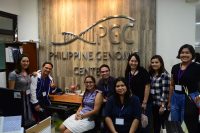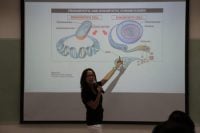Three members of the DNA Sequencing and Bioinformatics Facility of the Philippine Genome Center (PGC) attended the recently concluded Winter Institute for Statistical Genetics (WISG) held at the New York University Abu Dhabi (NYUAD), Abu Dhabi, United Arab Emirates, last January 22-24, 2017.

Prospects of fine-mapping trait-associated genomic regions using summary statistics from genome-wide association studies
Held usually at 3:30pm on Fridays, TGIF discussions are informal talks on current scientific topics and events.

Primer on Genomics and Bioinformatics Workshop
A workshop attended by PCHRD staff on basic molecular biology concepts and tools, genomes, and applications of genomics, introduction to DNA sequencing technologies, and introduction to Bioinformatics analysis for high-throughput sequencing data.

Imagining a Future with Synthetic Biology: Towards the Engineering of Microbial Cell Factories
Imagining a Future with Synthetic Biology: Towards the Engineering of Microbial Cell Factories

PGC Retreat and Strategic Planning
Poster presentations of PGC’s ongoing research projects and updates from program directors and core facilities.

Forest Canopy Genomics
Forest Canopy Genomics Small Group Workshop

Cataloging planetary biodiversity
The Centre for Biodiversity Genomics (CBG) is a research organization dedicated to furthering our understanding of the world’s fauna and flora. Through a variety of approaches, researchers at the institute are discovering, cataloging, and describing biodiversity. DNA barcoding, an innovative technique developed at CBG, utilizes DNA sequencing technology for species identification.

Economic Opportunities in Genomics
Over 20 of the Philippines’ biggest names in biotechnology and investment gathered last November 12, 2016 at a symposium hosted by the Philippine Genome Center (PGC) at the National Institute of Molecular Biology and Biotechnology with the aim of sharing insights on the scientific and economic value of genomics.

A tale of sex: gene sharing between microbial species, genomes and microbiomes
Horizontal gene transfer (HGT) is an important evolutionary process that allows the spread of innovations between distantly related organisms. In this webinar, I will present recent findings on the process, driving factors and impacts of HGT in light of recent developments in next-generation sequencing approaches. I will discuss examples of HGT within species, between species and between microbial communities, and how these gene exchange networks drive the genetic and phenotypic diversity of microbes in nature and clinical settings

Transcription Factor Assisted Loading and Enhancer Dynamics Dictate the Hepatic Fasting Response
Fasting elicits transcriptional programs in hepatocytes leading to glucose and ketone production. This transcriptional program is regulated by many transcription factors (TFs). To understands how this complex network regulates the metabolic response to fasting we aimed at isolating the enhancers and TFs dictating it. Measuring chromatin accessibility revealed that fasting massively reorganizes liver chromatin, exposing numerous fasting-induced enhancers.

